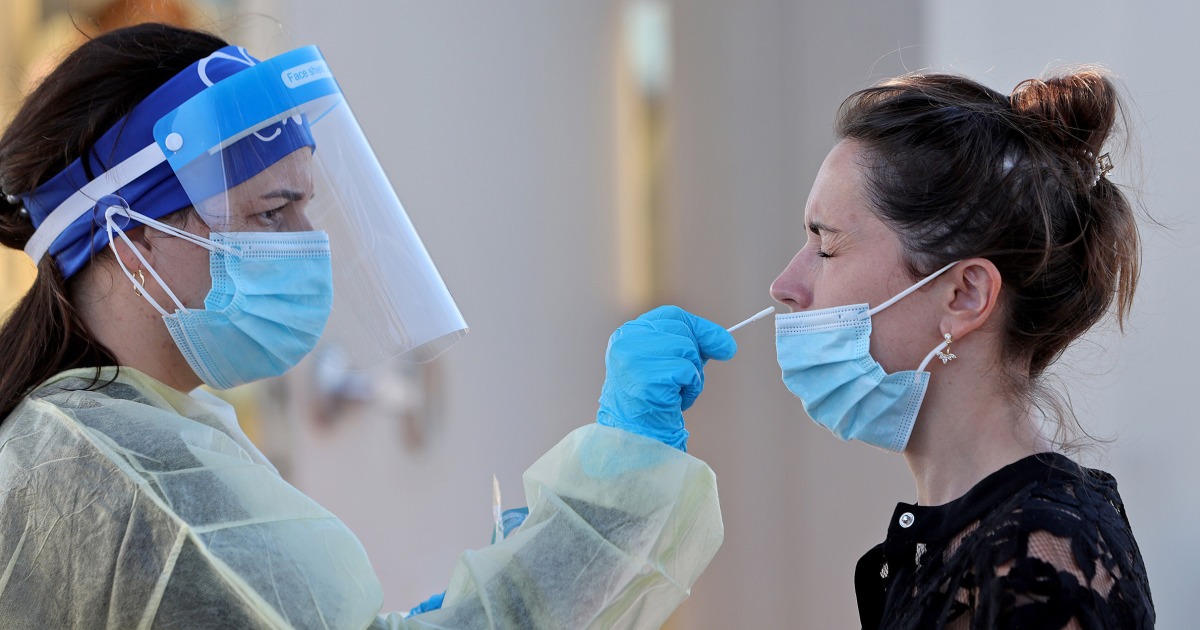
A wave of cases of the BA.2 omicron subvariant appears to finally be hitting the U.S.
Although the country’s Covid hospitalizations are at an all-time low, average daily case numbers have risen by 9 percent in the last two weeks, according to NBC News’ tally. Many experts agree that the true scale of the virus’s spread is far larger, because infections are being undercounted.
BA.2 accounts for around 86 percent of U.S. cases, according to the Centers for Disease Control and Prevention. But some of the agency’s guidelines about masking, testing and isolation have changed since the big omicron case wave earlier this year.
For those once again navigating what to do if you’re exposed or test positive, here’s what the CDC recommends.
When to wear a mask
- Since February, the CDC has based masking guidelines on three metrics — hospital capacity, new Covid cases and hospital admissions. Check your county’s risk level using the agency’s online tool to determine whether masks are needed. Immunocompromised people and people in their households should consult doctors about masking in medium-risk counties.
If you’ve been exposed to someone who tested positive
- People who are unvaccinated or haven’t been boosted should quarantine for at least five days. If symptoms appear, get a test as soon as possible. If you are symptom-free, get a test after five days. Either way, this group should wear masks around others and avoid travel for at least 10 days.
- Vaccinated and boosted people don’t need to quarantine unless they develop symptoms. If symptoms appear, get a test as soon as possible. If not, test after five days and wear a mask around others for 10 days.
- Those who’ve tested positive for Covid within 90 days before their exposure don’t have to quarantine or get tested, but they should still wear masks around others for 10 days.
If you have Covid symptoms
- Get a test and isolate for five days (your first day of symptoms is considered day zero). Wear a mask around others and avoid travel for at least 10 days.
If you test positive
- Isolate for at least five days after your positive test. Wear a mask around others and avoid travel for at least 10 days. If you develop symptoms in the middle of isolation, the five-day period starts over, with your first day of symptoms becoming day zero.
- Notify your close contacts — anyone you saw from less than 6 feet away for at least 15 minutes during the two days before your symptoms started or before you tested positive. Do so even if your contact was wearing a mask.
While isolating with a Covid infection
- If you live with others, try to stay in a separate room and use a separate bathroom. Wear a mask around anyone else in the household, wash your hands often, clean surfaces regularly and avoid sharing items like utensils or towels. Open doors and windows and turn on fans to improve airflow. Consider filtering the air in your home, either through settings on your HVAC system or by using a portable air cleaner.
- Stay hydrated and rest. You can take over-the-counter medications, such as Tylenol, to relieve symptoms like fever or muscle aches.
- People at high risk of severe disease should seek treatment quickly. Test to Treat locations offer prescriptions for antiviral pills to eligible people who test positive. The National Institutes of Health prefers Paxlovid, although Test to Treat sites also offer Lagevrio, another pill authorized by the Food and Drug Administration. Either must be taken within the first five days of symptoms.
- Go to the hospital if you develop severe symptoms, including trouble breathing, persistent pain or pressure in the chest or pale, gray or blue skin, lips or nail beds.
When to leave isolation
- If you are symptom-free, you can end isolation at least five days after your positive test.
- If you’ve been fever-free (without fever-reducing medications) for 24 hours and your symptoms are improving noticeably, you can also end isolation after five days.
- If you have access to a rapid test, use it five days after your first positive test. If it’s negative, you can end isolation, but you should keep wearing a mask around others for a total of 10 days after the start of symptoms or your first positive test. If you test positive again, extend your isolation to a total of 10 days. To improve the accuracy of rapid tests, it’s best to take two, spaced 24 to 48 hours apart. PCR tests may stay positive for up to 12 weeks, so they’re not useful for testing out of isolation.
- Immunocompromised people should isolate for 10 to 20 days after symptoms start, depending on their doctors’ advice.
- The CDC’s “quarantine and isolation calculator” can help you decide when to stay or leave home based on your circumstances.
Source: | This article originally belongs to Nbcnews.com









